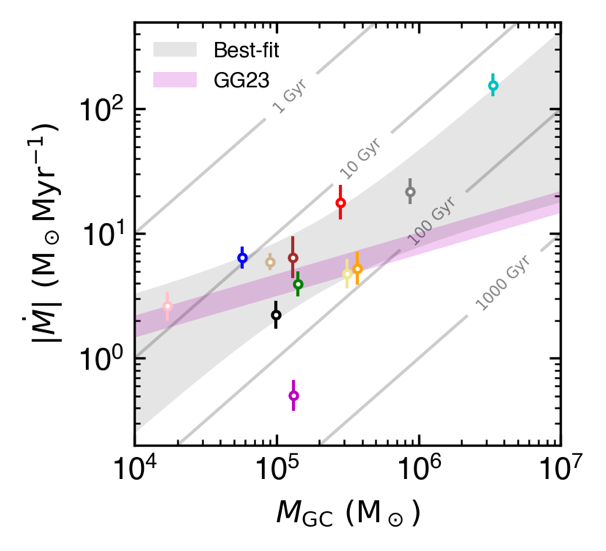Globular clusters are dense, ancient groups of stars orbiting galaxies like the Milky Way, often containing hundreds of thousands to even several million stars. Over billions of years, these clusters gradually lose mass due to two-body relaxation and tidal stripping. This slow unraveling process can eventually cause some clusters to dissolve entirely, contributing their stars to the galaxy's halo and disk.
Estimating the mass loss rate of globular clusters was previously thought to be a largely solved problem, with the dominant mechanisms well investigated through theoretical models and high-precision N-body simulations for decades. However, despite these theoretical advancements, no direct observational measurements have confirmed the predicted mass loss rates. The rapidly growing number of stellar streams detected around globular clusters by the Gaia mission now provides a unique opportunity to infer the mass loss rates from observations (Figure 1).

Figure 1. 3D map of stellar streams detected by May 2024. Right panel is a zoom-in view near the Galactic center. Credit: Ana Bonaca & Adrian Price-Whelan.
A team of astronomers from Tsinghua University and the University of Michigan has recently combined observations with dynamical modeling to present the first catalog of directly observed mass loss rates for 12 Galactic globular clusters. To achieve this, they applied a novel particle-spray algorithm specifically optimized for streams originating from globular clusters. By accurately modeling the width and length of these streams, the algorithm effectively resolves degeneracies in density measurements with an error margin of less than 10%.
The study found that the mass loss rates of globular clusters range from 0.5 to 200 solar masses per million years, depending on their mass and orbits. Among the 12 clusters, Omega Centauri exhibits the highest mass loss rate, likely due to its large mass and proximity to the Galactic center, where the tidal field is stronger. Moreover, the estimated mass loss rate correlates positively with cluster mass, as expected from theoretical models. However, the dependence on mass is much stronger than the most recent theoretical calculations in GG23 (Figure 2). This discrepancy poses a serious challenge to our understanding of collisional dynamics in dense stellar systems and offers new insights into the long-term evolution of globular clusters.

Figure 2. Mass loss rates of 12 Galactic globular clusters plotted against cluster mass. Grey area shows the observed relation, which has a much steeper slope compared to the GG23 theoretical model.
The paper was recently published in the Astrophysical Journal Letters (ApJL). Assistant Professor Hui Li from Tsinghua University is the corresponding author. The first author is Yingtian Chen, a PhD student from the University of Michigan. Professor Oleg Gnedin from the University of Michigan is the third author. This research was supported by the Ministry of Science and Technology Key R&D Program and the National Natural Science Foundation of China.
Article link: https://iopscience.iop.org/article/10.3847/2041-8213/adaf93


